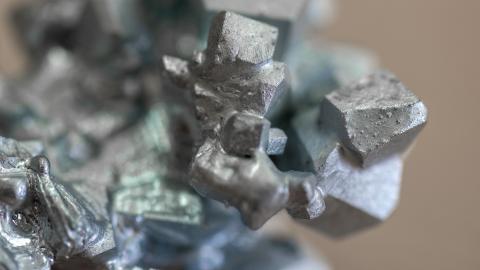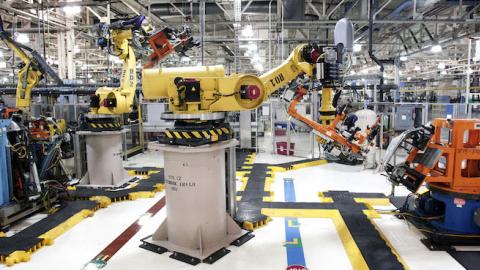The American economy added a mere 98,000 jobs last month, less than half the number expected. Not good enough for President Trump, who not only wants more jobs: He wants them for coal miners and those horny handed sons of toil who once were the backbone of the American manufacturing work force. To get jobs for miners he is conducting a bonfire of environmental regulations. To get manufacturing jobs he urged Chinese president Xi Jinping at their Mar-a-Lago meeting to abandon the unfair trade practices that have contributed to the hollowing out of the US manufacturing sector. Unfortunately, torching anti-coal regulations and haranguing Xi won't move Trump's jobs agenda significantly forward.
Start with the coal miners. "My administration is putting an end to the war on coal," the President announced when signing an order to unwind the regulatory web his predecessor spun around the mining and use of coal. Unfortunately, Trump can huff and puff and blow all the Obama regulations down, but he will generate no more than a handful of mining jobs. Between 2000 and 2016 production of coal in the U.S. declined by 40 percent, its share of fuels used by electricity generators from 50 percent to 30 percent, and the number of miners from over 70,000 to around 50,000. That decline will continue, for two reasons.
One is relatively cheap natural gas, the fossil fuel of choice of electric utilities. The other is the fact that presidents come and go, but the presidential pen remains in the White House, awaiting the next user, who may well revert to greener policies. Even if all Obama's regulations are repealed, even if the price of natural gas rises, no sensible investor is prepared to finance the construction of new coal-mining facilities, or coal-burning equipment with a useful life of perhaps forty years. Besides, an increasing number of CEOs believe the globe is warming and that it is in their companies' interest to reduce their carbon footprints. Trump's enthusiasm notwithstanding, coal mining is a declining business, the only question being how rapidly.
As for manufacturing employment, Trump faces a number of problems. Even if he is successful in closing off some imported goods, even if he is successful in creating an increased demand for workers, there might be few workers available to fill those slots. My informal survey of employers in several industries reveals one uniform complaint: "We can't find enough skilled workers." One major property developer with an annual land-acquisition budget of $1 billion told me the shortage of construction workers is so acute the industry is considering setting up a vocational training programme. Gad Levanon, an economist at the Conference Board, a research organization, says that the average time it takes an employer to fill a vacancy is higher than before the recession, and that employers are being forced to lower the qualifications they demand.
And David Neithercut, CEO of Equity Residential, a company that owns or has investments in over 85,000 apartments scattered in major cities around the country, told a television interviewer, "We're having trouble finding skilled labor to build the apartments and things that are under construction now, let alone where that skilled labor is going to come from to build $1 trillion of infrastructure." Which is one reason—fear of increasing the deficit is another—that enthusiasm for the president's infrastructure program is cooling, although not among Democrats, who have never met a spending program they dislike, or trade union bosses, who know enough economics to reckon that increased demand and constrained supply mean rising wages.
Not that there isn't a reserve army of the unemployed sitting on the sidelines. Some 5.6 million workers are involuntarily working only part-time; they can't find full time jobs. In addition, 1.6 million unemployed Americans have not looked for work in the past month. Many of these men and women have enlisted in Trump's "movement". They are unskilled, living in communities devastated by imports and technical change, incapable of learning the skills demanded of the modern economy, and in many cases addicted to opioids and other drugs. Trump, in his inaugural address described "Mothers and children trapped in poverty, rusted-out factories scattered like tombstones across the landscape of our nation … drugs have stolen too many lives…". No regulatory reform, no "fairer" trade policy can significantly alleviate the plight of these "forgotten men and women."
At a recent seminar over which I presided at Harvard several faculty members suggested to me that the solution is "education". But of what sort? Not necessarily what is on offer at our universities. Ben Casselman, a journalist and long-time student of the labor market points out that 62 percent of manufacturing production workers have no education past high school, and 80 percent have neither an associate nor a bachelor's degree. Manufacturers, he concludes, are struggling to find workers because they seek those with "industry-specific skills". Which suggests that part of the answer to the constrained labor supply would be employer-sponsored training of the sort the construction industry is considering. Such programs were once but no longer are provided by major U.S. companies and unions, lamented one faculty member at the Harvard session. The end of such programs because of a need to meet ever-higher quarterly earnings expectations explains why, when Angela Merkel visited Washington, Trump's staff sought information on Germany's successful apprenticeship program.
A final problem for Trump is that more rapid growth of the manufacturing sector will not necessarily lead to more jobs. At least, not for humans. A new study by Daron Acemoglu and Pascual Restrepo, economics professors at MIT and Boston University, respectively, concludes, "As robots and other computer-assisted technologies take over tasks previously performed by labor … we estimate large and robust negative effects of robots on employment and wages…" Which should appeal to employers. Andrew Puzder, the fast-food executive withdrew from consideration as Trump's labor secretary when it was revealed that he said robots are "always polite, they always upsell, they never take a vacation, they never show up late, there's never a slip-and-fall or an age-, sex- or race-discrimination case."
Almost 90 years ago John Maynard Keynes predicted that rapid technological progress in the next 90 years would afflict us with "a new disease … technological unemployment." He saw that as temporary, creating wealth and leisure, enabling us to "prefer the good to the useful." With 45 percent of U.S. workers at the risk of automation, according to McKinsey & Company, let's hope Keynes was right.
















